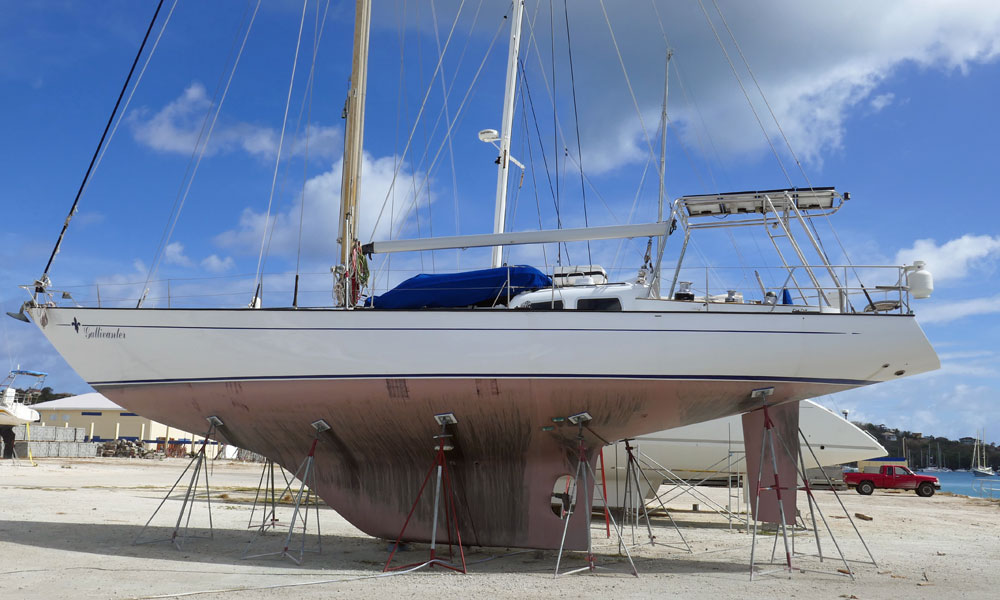- Home
- Design
Mastering Sailboat Design Ratios & Regulation for Performance & Safety
In a Nutshell: Why Understanding Sailboat Design Matters
Understanding sailboat design isn't just for naval architects—it's essential for every sailor who wants to make informed decisions about performance, comfort, and, most importantly, safety. Sailboat design ratios and regulatory categories provide a common language for comparing different vessels. They help you understand why one boat is fast in light winds but tender, while another is a stable, comfortable cruiser.
This guide breaks down these complex concepts into practical, easy-to-understand terms, equipping you with the knowledge to read a boat's "DNA" and predict how it will perform on the water.
Table of Contents
- What is a Sailboat Design Ratio & Why Are They Important?
- How Do Designers Balance Stability, Buoyancy & Performance?
- What Defines a Sailboat's Design Category & Stability?
- How Do Hull Shape & Ratios Affect Speed?
- How Can I Calculate & Use Performance Indicators?
- How Do Keel & Rudder Designs Work Together?
- How Do Materials & Construction Methods Influence Design?
- The Alacazam Project: Real-World Application
- Frequently Asked Questions (FAQ)
What is a Sailboat Design Ratio & Why Are They Important?
A sailboat design ratio is a mathematical expression that relates different aspects of a boat's physical dimensions or characteristics to each other. These ratios are non-dimensional, meaning they are independent of a boat's size, allowing for fair comparisons between a 25-foot daysailer and a 60-foot bluewater cruiser.
As an experienced offshore sailor well past the first flush of youth, I’ve found that these numbers—while they can seem dry—tell a powerful story. For instance, before a long passage, I always look at a boat's ballast ratio and its angle of vanishing stability (AVS). These figures give me a much better idea of how the boat will handle a storm than any sales brochure ever could. They are the backbone of yacht design, revealing a boat's intrinsic strengths and weaknesses.
How Do Designers Balance Stability, Buoyancy & Performance?
This is the central challenge of yacht design. Stability is a boat's ability to resist heeling and return to an upright position. Buoyancy is the upward force that keeps the boat afloat. Performance is a blend of speed, efficiency, and motion comfort.
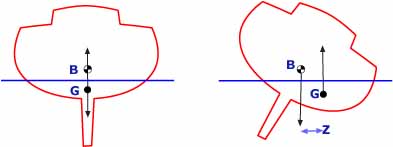 Relationship between Righting Moment (Z), Centre of Gravity (G) and Centre of Buoyancy (B)
Relationship between Righting Moment (Z), Centre of Gravity (G) and Centre of Buoyancy (B)Designers use a number of key ratios to strike this balance. For example, a high ballast ratio (ballast weight divided by total displacement) typically leads to greater stability, as does a wide beam, which contributes to "form stability." However, a very wide hull can also be less comfortable in a seaway, with a quick, jerky motion. These trade-offs are at the heart of every design choice. For a complete look at these foundational concepts, read our full guide on "Understanding Sailboat Stability, Buoyancy & Performance".
What Defines a Sailboat's Design Category & Stability?
Sailboat design categories are part of an international effort to standardize vessel safety, particularly for recreational boats. The European Union's Recreational Craft Directive (RCD) establishes four design categories (A, B, C, & D), which classify boats based on their ability to withstand certain wind and sea conditions. To understand these classifications, explore "A Guide to Sailboat Design Categories, STIX & Dynamic Stability".
One of the most important tools for assessing a boat’s ultimate stability is the Gz Curve, or the Righting Arm Curve. This graph plots the boat's righting arm (Gz) against its heel angle. For a thorough explanation of what these graphs reveal, see our article on "Reading the All-Revealing Gz Curve for Sailboat Stability".
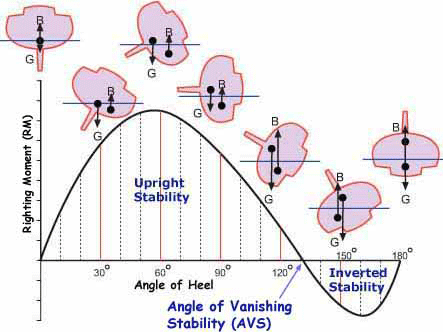 A Gz curve
A Gz curve| Key Stability Concepts | Description & Relevance |
|---|---|
| Angle of Vanishing Stability (AVS) | The angle of heel where the righting moment becomes zero. A boat will capsize beyond this point. AVS is a key indicator of a boat's offshore capability. |
| STIX | A numerical index used to assess a sailboat's overall stability characteristics, derived from the RCD. Higher numbers generally indicate greater stability. |
| Righting Moment | The force that acts to return a heeling boat to its upright position. It's a key component of the Gz curve and is influenced by both hull shape and ballast. For more on this, see What is the Righting Moment & How it Affects Sailboat Stability. |
How Do Hull Shape & Ratios Affect Speed?
A boat's speed potential is primarily determined by two factors: the energy available to push it through the water and the drag it experiences. Sailboat design ratios provide insight into both.
- Prismatic Coefficient: This ratio describes the fineness of the hull's ends. For a deep look at this ratio and its effects on performance, see our article on "The Prismatic Coefficient Explained: Its Role in Yacht Design".
- Hullspeed & the Speed/Length Ratio: Hullspeed is the theoretical maximum speed of a displacement hull, a figure determined by its waterline length. The Speed/Length ratio is a simple, yet powerful, indicator of a boat's speed potential. We cover this in depth in "Calculating Hullspeed & the Speed/Length Ratio".
- Hull Drag & Wavemaking Resistance: These are the forces a hull has to overcome to move through the water. While a deep keel helps with upwind performance, it also creates significant drag. Designers must find the optimal balance between these forces to achieve a fast, efficient hull. Learn more in "Minimizing Hull Drag & Wavemaking Resistance for Speed".
How Can I Calculate & Use Performance Indicators?
Putting it all together, several ratios help you compare a boat's overall performance potential. For a comprehensive look at how these numbers are used, check out our guide on "Using Boat Displacement/Length & Other Key Performance Ratios".
- Displacement/Length Ratio: A low number indicates a lightweight, easily-driven boat, while a high number points to a heavier, more comfortable cruiser.
- Sail Area/Displacement Ratio: This is analogous to a car's horsepower-to-weight ratio. A high SA/D ratio suggests a boat with plenty of sail power for its weight, which translates to better performance in light winds.
- Ballast Ratio: A higher ballast ratio indicates that a larger portion of the boat's weight is dedicated to ballast, which generally leads to a stiffer, more stable boat.
For step-by-step instructions on performing these calculations yourself, see "A Step-by-Step Guide to Calculating Sailboat Design Ratios".
How Do Keel & Rudder Designs Work Together?
A sailboat's performance and handling are defined by the hydrodynamics of its keel and rudder working in concert. The keel provides the primary lateral resistance, while the rudder provides directional control and fine-tunes the boat's course. The type of keel and rudder—from full keels with barn-door rudders to modern fin keels with spade rudders—creates a unique set of handling characteristics.
For a detailed look at the trade-offs between deep fin performance and shoal draft convenience, explore: "Sailboat Keels & Ballast: A Guide to Design, Materials & Performance".
To learn more about the critical role of the rudder in this relationship, see our guide: "Sailboat Rudders: How Design Affects Handling & Performance".
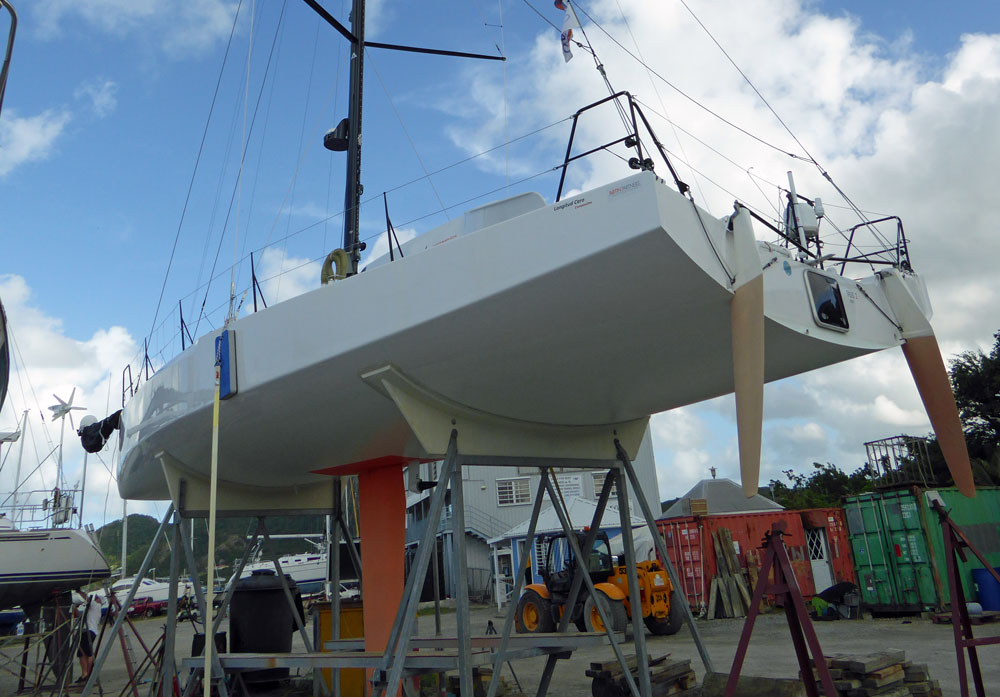 Twin high-aspect ratio rudders on this ultra-light displacement race boat
Twin high-aspect ratio rudders on this ultra-light displacement race boatHow Do Materials & Construction Methods Influence Design?
The materials used in a boat's construction fundamentally shape its design and performance. From traditional wood to modern composites, each material offers a unique set of trade-offs in terms of weight, strength, cost, and maintenance. For example, the use of carbon fiber and other advanced composites allows for extremely lightweight hulls, enabling designers to place more weight in the keel bulb for increased righting moment and speed. This has a direct impact on the boat's ballast ratio and overall sailing characteristics. For more on hull materials and construction techniques, take a look at "Sailboat Construction Materials: From Traditional Wood to Modern Composites".
The Alacazam Project: Real-World Application
While the theory behind sailboat design ratios provides a crucial framework, there is no substitute for the practical experience of putting those principles into action. Our 38-foot cruising sailboat, Alacazam, stands as a testament to the application of these concepts in a hands-on, wood epoxy build. Working closely with the designer, my involvement in every aspect of her creation provides a first-hand account of how design principles translate from the drawing board to a robust, ocean-going vessel.
In my article "The Design and Construction of Alacazam: A Wood Epoxy Sailboat", we take a practical journey through her creation. We explore the choice of wood epoxy as a construction material, detailing why its strength-to-weight ratio and resistance to osmosis made it the ideal choice for an offshore cruising boat. We also discuss the challenges and triumphs of her construction, from lofting the lines to applying the final sheathing. This article is not merely a technical report; it is my personal narrative of building a dream, offering a tangible example of the principles discussed within this page.
By telling Alacazam's story, we provide a real-world case study, demonstrating the successful application of the design ratios and safety regulations that form the foundation of this guide.
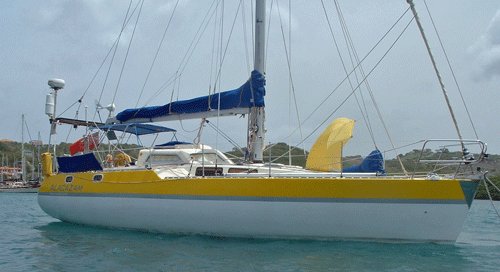 But was it all worth it? You bet it was!
But was it all worth it? You bet it was!This article was written by Dick McClary, RYA Yachtmaster and author of the RYA publications 'Offshore Sailing' and 'Fishing Afloat', member of The Yachting Journalists Association (YJA), and erstwhile member of the Ocean Cruising Club (OCC).
Frequently Asked Questions (FAQ)
What is the ideal Sail Area/Displacement (SA/D) ratio for a cruising sailboat?
What is the ideal Sail Area/Displacement (SA/D) ratio for a cruising sailboat?
A cruising sailboat typically has an SA/D ratio between 15 and 20. Anything below 15 may feel underpowered, while anything above 20 suggests a high-performance boat that may be less comfortable for long-distance cruising.
Does a high ballast ratio guarantee a safe boat?
Does a high ballast ratio guarantee a safe boat?
Not necessarily. While a high ballast ratio is a good indicator of initial stiffness, ultimate safety depends on many factors, including the hull shape, freeboard, and especially the Angle of Vanishing Stability.
How does the Prismatic Coefficient (Cp) affect a boat's ride?
How does the Prismatic Coefficient (Cp) affect a boat's ride?
A boat with a low Cp (finer ends) tends to cut through waves more cleanly, providing a smoother ride. A boat with a high Cp (fuller ends) can "pound" in a head sea, which is uncomfortable for the crew.
Sources Used:
- Gerr, D. (n.d.). Stability Is The Key – Part 2. Gerr Marine. https://www.gerrmarine.com/Articles/stabilitypart2.pdf
- Stadel, R. (2013, March 22). MODERN SAILBOAT DESIGN: Form Stability. Wave Train. https://wavetrain.net/2013/03/22/modern-sailboat-design-form-stability/
- Phelps, A. (2015, December 13). Comparing Design Ratios. Sail Magazine. https://sailmagazine.com/boats/comparing-design-ratios/
- The Royal Yachting Association. (n.d.). Pleasure craft regulations. https://www.rya.org.uk/knowledge/regulations/pleasure-craft
Recent Articles
-
Modern Boat Electronics and the Latest Marine Instruments
Dec 20, 25 05:27 PM
Should sailboat instruments be linked to the latest boat electronics as a fully integrated system, or is it best to leave them as independent units? -
Hans Christian 43: Classic Bluewater Cruiser & Liveaboard Sailboat
Dec 10, 25 04:37 AM
Explore the Hans Christian 43: a legendary heavy-displacement, long-keel sailboat. Read our in-depth review of its specs, design ratios, and suitability for offshore cruising and living aboard. -
Planning Your Sailboat Liveaboard Lifestyle: An Ocean Sailor's Guide
Dec 06, 25 05:18 AM
Seasoned sailors share their methodical risk analysis for planning a secure Sailboat Liveaboard Lifestyle, covering financial, property, and relationship risks.
